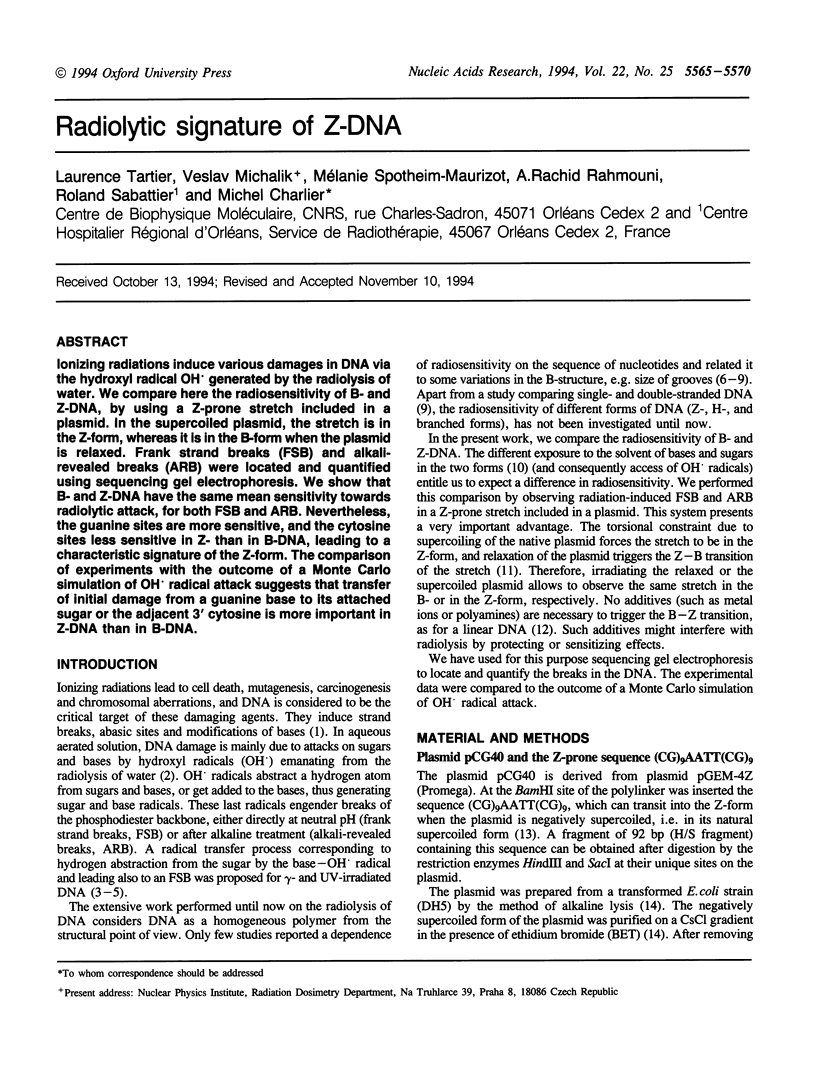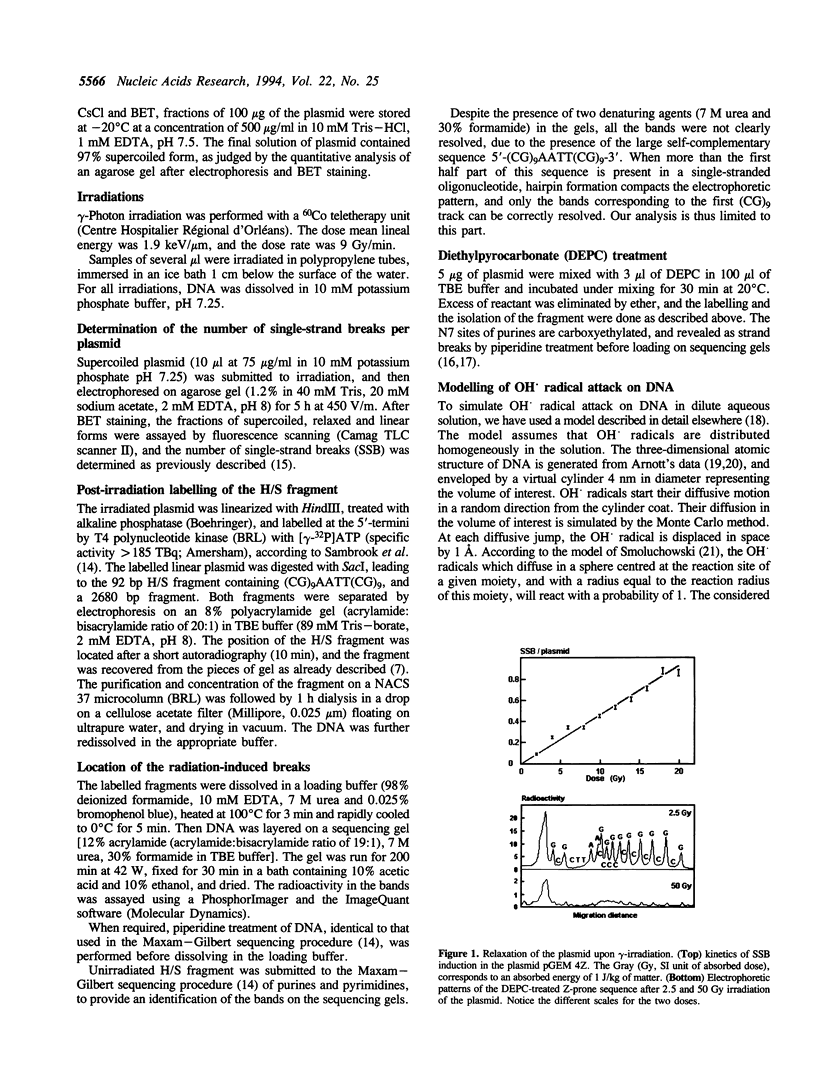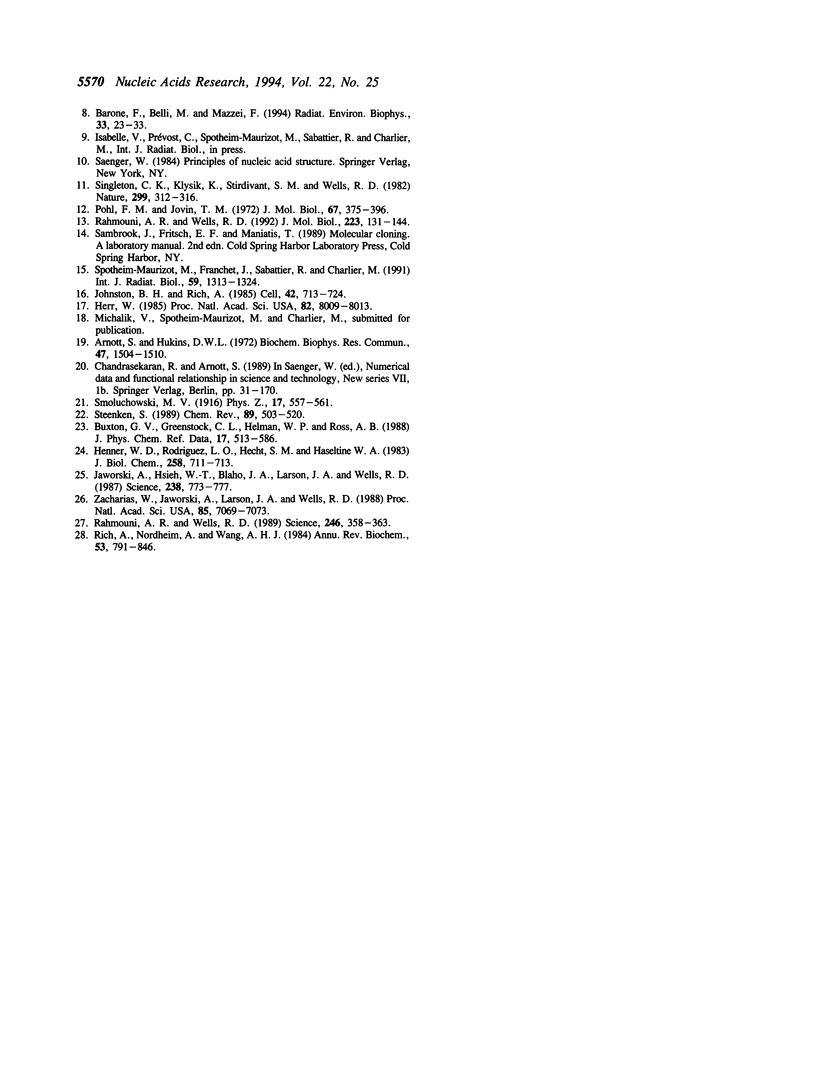Abstract
Ionizing radiations induce various damages in DNA via the hydroxyl radical OH. generated by the radiolysis of water. We compare here the radiosensitivity of B- and Z-DNA, by using a Z-prone stretch included in a plasmid. In the supercoiled plasmid, the stretch is in the Z-form, whereas it is in the B-form when the plasmid is relaxed. Frank strand breaks (FSB) and alkali-revealed breaks (ARB) were located and quantified using sequencing gel electrophoresis. We show that B- and Z-DNA have the same mean sensitivity towards radiolytic attack, for both FSB and ARB. Nevertheless, the guanine sites are more sensitive, and the cytosine sites less sensitive in Z- than in B-DNA, leading to a characteristic signature of the Z-form. The comparison of experiments with the outcome of a Monte Carlo simulation of OH. radical attack suggests that transfer of initial damage from a guanine base to its attached sugar or the adjacent 3' cytosine is more important in Z-DNA than in B-DNA.
Full text
PDF





Selected References
These references are in PubMed. This may not be the complete list of references from this article.
- Arnott S., Hukins D. W. Optimised parameters for A-DNA and B-DNA. Biochem Biophys Res Commun. 1972 Jun 28;47(6):1504–1509. doi: 10.1016/0006-291X(72)90243-4. [DOI] [PubMed] [Google Scholar]
- Barone F., Belli M., Mazzei F. Influence of DNA conformation on radiation-induced single-strand breaks. Radiat Environ Biophys. 1994;33(1):23–33. doi: 10.1007/BF01255271. [DOI] [PubMed] [Google Scholar]
- Denison L., Haigh A., D'Cunha G., Martin R. F. DNA ligands as radioprotectors: molecular studies with Hoechst 33342 and Hoechst 33258. Int J Radiat Biol. 1992 Jan;61(1):69–81. doi: 10.1080/09553009214550641. [DOI] [PubMed] [Google Scholar]
- Franchet-Beuzit J., Spotheim-Maurizot M., Sabattier R., Blazy-Baudras B., Charlier M. Radiolytic footprinting. Beta rays, gamma photons, and fast neutrons probe DNA-protein interactions. Biochemistry. 1993 Mar 2;32(8):2104–2110. doi: 10.1021/bi00059a031. [DOI] [PubMed] [Google Scholar]
- Henner W. D., Rodriguez L. O., Hecht S. M., Haseltine W. A. gamma Ray induced deoxyribonucleic acid strand breaks. 3' Glycolate termini. J Biol Chem. 1983 Jan 25;258(2):711–713. [PubMed] [Google Scholar]
- Herr W. Diethyl pyrocarbonate: a chemical probe for secondary structure in negatively supercoiled DNA. Proc Natl Acad Sci U S A. 1985 Dec;82(23):8009–8013. doi: 10.1073/pnas.82.23.8009. [DOI] [PMC free article] [PubMed] [Google Scholar]
- Hildenbrand K., Schulte-Frohlinde D. E.s.r. studies on the mechanism of hydroxyl radical-induced strand breakage of polyuridylic acid. Int J Radiat Biol. 1989 May;55(5):725–738. doi: 10.1080/09553008914550781. [DOI] [PubMed] [Google Scholar]
- Jaworski A., Hsieh W. T., Blaho J. A., Larson J. E., Wells R. D. Left-handed DNA in vivo. Science. 1987 Nov 6;238(4828):773–777. doi: 10.1126/science.3313728. [DOI] [PubMed] [Google Scholar]
- Johnston B. H., Rich A. Chemical probes of DNA conformation: detection of Z-DNA at nucleotide resolution. Cell. 1985 Oct;42(3):713–724. doi: 10.1016/0092-8674(85)90268-5. [DOI] [PubMed] [Google Scholar]
- Karam L. R., Dizdaroglu M., Simic M. G. Intramolecular H atom abstraction from the sugar moiety by thymine radicals in oligo- and polydeoxynucleotides. Radiat Res. 1988 Nov;116(2):210–216. [PubMed] [Google Scholar]
- Pohl F. M., Jovin T. M. Salt-induced co-operative conformational change of a synthetic DNA: equilibrium and kinetic studies with poly (dG-dC). J Mol Biol. 1972 Jun 28;67(3):375–396. doi: 10.1016/0022-2836(72)90457-3. [DOI] [PubMed] [Google Scholar]
- Rahmouni A. R., Wells R. D. Direct evidence for the effect of transcription on local DNA supercoiling in vivo. J Mol Biol. 1992 Jan 5;223(1):131–144. doi: 10.1016/0022-2836(92)90721-u. [DOI] [PubMed] [Google Scholar]
- Rahmouni A. R., Wells R. D. Stabilization of Z DNA in vivo by localized supercoiling. Science. 1989 Oct 20;246(4928):358–363. doi: 10.1126/science.2678475. [DOI] [PubMed] [Google Scholar]
- Rich A., Nordheim A., Wang A. H. The chemistry and biology of left-handed Z-DNA. Annu Rev Biochem. 1984;53:791–846. doi: 10.1146/annurev.bi.53.070184.004043. [DOI] [PubMed] [Google Scholar]
- Singleton C. K., Klysik J., Stirdivant S. M., Wells R. D. Left-handed Z-DNA is induced by supercoiling in physiological ionic conditions. Nature. 1982 Sep 23;299(5881):312–316. doi: 10.1038/299312a0. [DOI] [PubMed] [Google Scholar]
- Spotheim-Maurizot M., Franchet J., Sabattier R., Charlier M. DNA radiolysis by fast neutrons. II. Oxygen, thiols and ionic strength effects. Int J Radiat Biol. 1991 Jun;59(6):1313–1324. doi: 10.1080/09553009114551191. [DOI] [PubMed] [Google Scholar]
- Zacharias W., Jaworski A., Larson J. E., Wells R. D. The B- to Z-DNA equilibrium in vivo is perturbed by biological processes. Proc Natl Acad Sci U S A. 1988 Oct;85(19):7069–7073. doi: 10.1073/pnas.85.19.7069. [DOI] [PMC free article] [PubMed] [Google Scholar]


